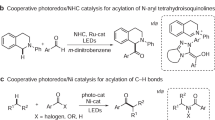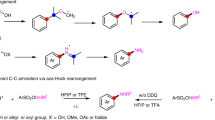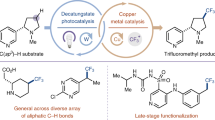Abstract
The direct functionalization of unactivated sp3 C–H bonds is still one of the most challenging problems facing synthetic organic chemists. The appeal of such transformations derives from their capacity to facilitate the construction of complex organic molecules via the coupling of simple and otherwise inert building blocks, without introducing extraneous functional groups. Despite notable recent efforts1, the establishment of general and mild strategies for the engagement of sp3 C–H bonds in C–C bond forming reactions has proved difficult. Within this context, the discovery of chemical transformations that are able to directly functionalize allylic methyl, methylene and methine carbons in a catalytic manner is a priority. Although protocols for direct oxidation and amination of allylic C–H bonds (that is, C–H bonds where an adjacent carbon is involved in a C = C bond) have become widely established2,3, the engagement of allylic substrates in C–C bond forming reactions has thus far required the use of pre-functionalized coupling partners4. In particular, the direct arylation of non-functionalized allylic systems would enable access to a series of known pharmacophores (molecular features responsible for a drug’s action), though a general solution to this long-standing challenge remains elusive. Here we report the use of both photoredox and organic catalysis to accomplish a mild, broadly effective direct allylic C–H arylation. This C–C bond forming reaction readily accommodates a broad range of alkene and electron-deficient arene reactants, and has been used in the direct arylation of benzylic C–H bonds.
This is a preview of subscription content, access via your institution
Access options
Subscribe to this journal
Receive 51 print issues and online access
$199.00 per year
only $3.90 per issue
Buy this article
- Purchase on Springer Link
- Instant access to full article PDF
Prices may be subject to local taxes which are calculated during checkout




Similar content being viewed by others
References
He, J. et al. Ligand-controlled C(sp3)–H arylation and olefination in synthesis of unnatural chiral α-amino acids. Science 343, 1216–1220 (2014)
Eames, J. & Watkinson, M. Catalytic allylic oxidation of alkenes using an asymmetric Kharasch-Sosnovsky reaction. Angew. Chem. Int. Edn 40, 3567–3571 (2001)
Johannsen, M. & Jørgensen, K. A. Allylic amination. Chem. Rev. 98, 1689–1708 (1998)
Trost, B. M. & Van Vranken, D. L. Asymmetric transition metal-catalyzed allylic alkylations. Chem. Rev. 96, 395–422 (1996)
Borg, R. M., Arnold, D. R. & Cameron, T. S. Radical ions in photochemistry. 15. The photosubstitution reaction between dicyanobenzenes and alkyl olefins. Can. J. Chem. 62, 1785–1802 (1984)
Hoshikawa, T. & Inoue, M. Photoinduced direct 4-pyridination of C(sp3)–H bonds. Chem. Sci. 4, 3118–3123 (2013)
Sekine, M., Ilies, L. & Nakamura, E. Iron-catalyzed allylic arylation of olefins via C(sp3)–H activation under mild conditions. Org. Lett. 15, 714–717 (2013)
Narayanam, J. M. R. & Stephenson, C. R. J. Visible light photoredox catalysis: applications in organic synthesis. Chem. Soc. Rev. 40, 102–113 (2011)
Prier, C. K., Rankic, D. A. & MacMillan, D. W. C. Visible light photoredox catalysis with transition metal complexes: applications in organic synthesis. Chem. Rev. 113, 5322–5363 (2013)
Schultz, D. M. & Yoon, T. P. Solar synthesis: prospects in visible light photocatalysis. Science 343, 1239176 (2014)
Nicewicz, D. A. & MacMillan, D. W. C. Merging photoredox catalysis with organocatalysis: the direct asymmetric alkylation of aldehydes. Science 322, 77–80 (2008)
Nagib, D. A., Scott, M. E. & MacMillan, D. W. C. Enantioselective α-trifluoromethylation of aldehydes via photoredox organocatalysis. J. Am. Chem. Soc. 131, 10875–10877 (2009)
Pirnot, M. T., Rankic, D. A., Martin, D. B. C. & MacMillan, D. W. C. Photoredox activation for the direct β-arylation of ketones and aldehydes. Science 339, 1593–1596 (2013)
Qvortrup, K., Rankic, D. A. & MacMillan, D. W. C. A general strategy for organocatalytic activation of C–H bonds via photoredox catalysis: direct arylation of benzylic ethers. J. Am. Chem. Soc. 136, 626–629 (2014)
Khursan, S. L., Mikhailov, D. A., Yanborisov, V. M. & Borisov, D. I. AM1 Calculations of bond dissociation energies. Allylic and benzylic C–H bonds. React. Kinet. Catal. Lett. 61, 91–95 (1997)
Flamigni, L., Barbieri, A., Sabatini, C., Ventura, B. & Barigelletti, F. Photochemistry and photophysics of coordination compounds: iridium. Top. Curr. Chem. 281, 143–203 (2007)
Mori, Y., Sakaguchi, Y. & Hayashi, H. Magnetic field effects on chemical reactions of biradical ion pairs in homogeneous fluid solvents. J. Phys. Chem. A 104, 4896–4905 (2000)
Ogawa, K. A. & Boydston, A. J. Organocatalyzed anodic oxidation of aldehydes to thioesters. Org. Lett. 16, 1928–1931 (2014)
Jencks, W. P. & Salvesen, K. Equilibrium deuterium isotope effects on the ionization of thiol acids. J. Am. Chem. Soc. 93, 4433–4436 (1971)
Denisov, E., Chatgilialoglu, C., Shestakov, A. & Denisova, T. Rate constants and transition-state geometry of reactions of alkyl, alkoxyl, and peroxyl radicals with thiols. Int. J. Chem. Kinet. 41, 284–293 (2009)
McMillen, D. F. & Golden, D. M. Hydrocarbon bond dissociation energies. Annu. Rev. Phys. Chem. 33, 493–532 (1982)
Acknowledgements
Financial support was provided by NIHGMS (R01 GM103558-03), and we also thank Merck and Amgen for funding. J.D.C. thanks Marie Curie Actions for an International Outgoing Fellowship.
Author information
Authors and Affiliations
Contributions
J.D.C. performed and analysed experiments. J.D.C. and D.W.C.M. designed experiments to develop this reaction and probe its utility, and also prepared this manuscript.
Corresponding author
Ethics declarations
Competing interests
The authors declare no competing financial interests.
Supplementary information
Supplementary Information
This file contains Supplementary Text and Data – see Contents for details. (PDF 10395 kb)
Rights and permissions
About this article
Cite this article
Cuthbertson, J., MacMillan, D. The direct arylation of allylic sp3 C–H bonds via organic and photoredox catalysis. Nature 519, 74–77 (2015). https://doi.org/10.1038/nature14255
Received:
Accepted:
Published:
Issue Date:
DOI: https://doi.org/10.1038/nature14255
This article is cited by
-
Room temperature photo-promoted iron-catalysed arene C–H alkenylation without Grignard reagents
Nature Catalysis (2024)
-
Metal-free photoinduced C(sp3)–H/C(sp3)–H cross-coupling to access α‑tertiary amino acid derivatives
Nature Communications (2023)
-
Direct allylic acylation via cross-coupling involving cooperative N‑heterocyclic carbene, hydrogen atom transfer, and photoredox catalysis
Nature Communications (2023)
-
Three catalysts tango with olefins
Nature Synthesis (2022)
-
Allylic C(sp3)–H arylation of olefins via ternary catalysis
Nature Synthesis (2022)
Comments
By submitting a comment you agree to abide by our Terms and Community Guidelines. If you find something abusive or that does not comply with our terms or guidelines please flag it as inappropriate.



